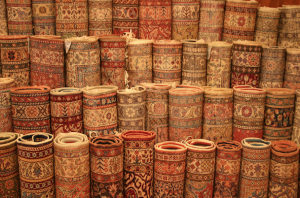We clean all types of rugs at Dry-N-Clean, including Oriental rugs. However, you would be surprised at how many types of Oriental rugs are actually out there.
First, there are Aubusson rugs- these originate from the villages of Aubusson and Felletin in central France- however they are produced now in China, India and Pakistan. They are typically quite large with a soft pile. They usually come in soft pastels and ivories with floral motifs.
Next, there are Bokhara rugs. These jewel toned rugs come from Pakistan, Afghanistan and central Asia. The size varies, and the design consists of a highly stylized pattern that repeats over the entire surface of the rug. Chobi rugs, which are also known as Peshawar rugs are traditionally produced in Pakistan. The size varies on these antiqued looking rugs, boasting earthy, golden tones differing shades of one color or abrash throughout the pile. They have symmetrical border patterns and floral motifs.
The Gabbeh rug is a style of Persian rug that usually is found to be made in southwest Iran. Gabbeh is Farsi for “raw or natural, uncut or ‘in the rough’”. They are medium to large rugs with a palette of 5-7 bright colors. They can often be mistaken as modern style rugs because of the stripes or geometric patterns that they boast.
Kazak rugs are maybe what comes to mind when you hear a rug described as an Oriental rug. Though Qazak is a city in Northwest Azerbaijan but Kazak rugs are most traditionally woven in Afghanistan and Armenia. The size can vary, and the geometric motif of animals, flowers, and tribal medallions come in 3-7 colors, commonly palettes of deep indigo, reds and ivory.
Next, Khotan rugs hail from from the ancient city of Khotan (Hotan) in the southern region of Xinjiang, which is Chinese Turkistan. You’ll find these rugs to be longer and narrower than standard rugs, and their colors can be rich and warm or light and pastel. Their designs incorporates Chinese and central Asian influences, stylized geometrics and floral patterns.
Oushak rugs, which are also called Ushak rugs, originate from Turkey. They can range from medium to large in size, featuring silky, shimmery wool in shades of cinnamon, terra-cotta, grey and soft pastels. They hold large-scale geometric floral patterns. Overdyed Rugs began in Istanbul as a way to brighten old, faded woven rugs. The sizes vary, and the original colors of the rug are diffused via bleaching and washing techniques, and the rug is re-dyed in one solid color. The result is that the original pattern and design are visible through the one muted color.
Persian Medallion rugs, which can also be called Kashan rugs come from Iran and Pakistan, with varying sizes and can come in diverse palettes of 15-25 colors. Typically they hold floral motifs with a unique central medallion. Finally, there are the Qashqai rugs. These lovely rugs come from Iran, with varying sizes, and they typically feature 6-9 alternating colors, which range from deep indigo blue, deep reds or even gold colors. The designs are bold geometric designs submersed with tribal symbols.
The care of your Oriental rug is paramount- these rugs can be costly, and are often family heirlooms. If you get a stain on your rug, respond immediately. Do NOT let it sit. The longer you let a stain sit on these rugs, the more likely it will be damaged permanently. But more than that, keep maintenance on your rug, clean it monthly. Make sure you clean it once a month- it may look clean but rugs pick up ton of dirt that you may not see. Flip the rug regularly so that no area side sustains more damage from the sun or everyday use than another. Vacuum both sides- again, keeping both sides healthy is extremely important. Another thing to note is that you never want to use harsh chemicals on these rugs- most of them have been colored with vegetable dyes, which can be easily discolored by anything harsher than vinegar. Harsh chemicals encourage discoloration, and you can’t remove soap without rinsing it with a hose, which will cause the colors to run. Mix your vinegar and water concoction in a spray bottle and lightly spray the rug evenly. Allow it to dry. You can use a light brush and work it through the fringes as if you are brushing hair. Please note that if the fringes are pure white, it can mean it is cotton. Apply less vinegar and place a fan on the fringes to dry it faster. Cotton fringes are known to turn brown from the cotton fibers. Once you’ve cleaned the rug, put a floor fan on it to dry faster, this prevents mildew. Do not hang your rug when its still dripping wet, this will cause the colors to run, you may, however, hang the rug while its damp.
At Dry-N-Clean, we have a speciality rug cleaning process that leaves your rug fresh and bright. First we check out the rug on a minute level, measuring and inspecting for spots, stains, burns or even holes. We perform pH and dye transfer tests to ensure that we do not cause damage to your rug in the process of cleaning it. We then execute a preliminary vacuum to remove any hidden loose dirt or pet hair, using our high-impact dusting system: Rugbadger. Next we pre-spot the rug in order to break down set-in stains. As always, we use a specially formulated shame-cleanser before breaking out our triple-planetary rotary machine to clear away any remaining debris. Last, we perform a hot-water vacuum rinse. We quick-dry your rug while cleaning up our materials. If your rug has fringes around the sides, our professional rug and carpet cleaning crew will carefully brush them out and shampoo them to restore their original color and texture.
To recap: keep an eye on your rugs at home with these simple steps
-Turn/rotate your Oriental rug occasionally to keep one side from being exposed to the sun continuously.
-Take action against stains and spills immediately.
-For wax: cover spilled wax with a brown paper bag and hold an iron over top. Move the iron constantly to avoid burning the rug and pull away when wax has absorbed into blotting paper.
-For gum: press and ice cube against gun until it becomes cold and brittle. You should be able to remove most of it; use spot cleaner, vinegar or alcohol to clear away any trances.
-For ink: spray spot with hairspray, wait for it to dry and then brush gentle with a mixture of vinegar and water.



Leave A Comment